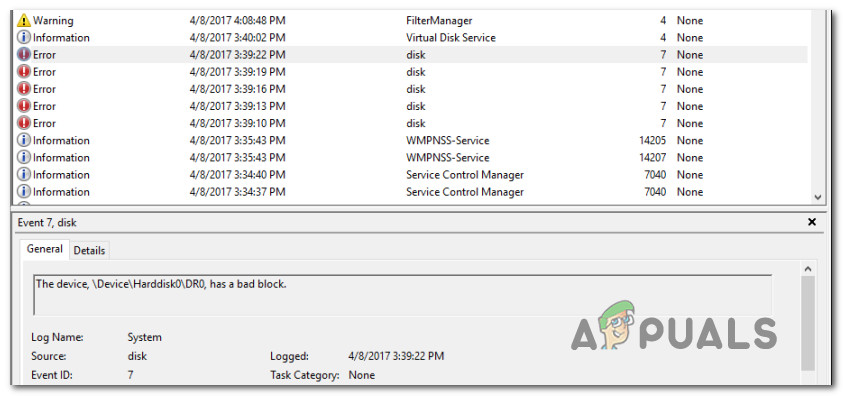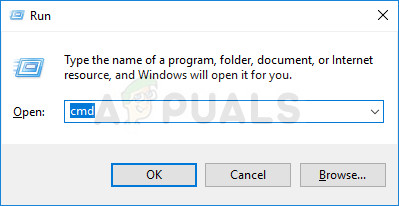Fix: The Device \Device\Harddisk0\DR0 Has a Bad Block
Several users have been reaching us with questions after opening the Event Viewer and noticing a lot of Disk errors with the message “The Device \Device\Harddisk0\DR0 has a bad block” error. This particular issue is reported to occur on multiple Windows version. Most affected users report that they also started to notice performance drops once the Event Viewer error has started to occur consistently.

What is causing the “Device \Device\Harddisk0\DR0 Has a Bad Block” error?
We investigated this particular issue by looking at various user reports and the repair strategies that they used to get the issue resolved.
From what we gathered, this particular error is indicative that a bad block was found on the first partition of your drive. Keep in mind that one a data block goes bad, there’s no way to make it healthy again. But you can force your operating system to make the block as being bad and avoid using it in the future. This will avoid any data loss scenarios where you’ll need to use a data recovery program.
Unfortunately, the “The Device \Device\Harddisk0\DR0 has a bad block” error is one of the first signs that your drive is going bad. If you’re seeing this message, we advise you to start by making sure all your data is backed up so you’re protected in case things the symptoms escalate.
If you’re struggling to resolve this particular error message, this article will provide you with several troubleshooting steps. Down below, you’ll find a collection of methods that other users in a similar situation have successfully used to deal with the Event Viewer errors.
Important: Keep in mind that the methods below will only work for as long as the drive still has some healthy unused sectors that can be used to replace the bad ones or the errors are actually false positives. Otherwise, you’ll have little choice but to purchase a new drive and migrate your data there.
Method 1: Running a CHKDSK scan
The most convenable way of resolving the “The Device \Device\Harddisk0\DR0 has a bad block” error is to perform a CHKDSK scan. This built-in utility will scan through your entire hard drive for bad sectors and replace any corrupted occurrences with a healthy sector.
Here’s a quick guide on running a CHKDSK scan to resolve the error:
- Press Windows key + R to open up a Run dialog box. Then, type “cmd” and press Ctrl + Shift + Enter to open up an elevated Command Prompt. When prompted by the UAC (User Account Control), click Yes to grant administrative privileges.

Running CMD as an admin - Inside the elevated Command Prompt, type the following command and press Enter to initiate CHKDSK scan:
chkdsk /f /r
- If you’re asked whether you want to schedule the operation at the next reboot, type the letter Y and then Enter to schedule it.
- Restart your computer and let the CHKDSK operation to complete at the next system startup.
Note: Do not shut down your computer while the CHKDSK operation is occurring. Doing this might cause irreversible damage to your HDD/SSD and render your Windows installation unusable. - Open the Event Viewer and see if you’re still seeing new events with the “The Device \Device\Harddisk0\DR0 has a bad block” error.
Method 2: Running a System File Checker scan
If CHKDSK scan didn’t manage to find any bad sectors, let’s see if a System File Checker scan manages to resolve the “The Device \Device\Harddisk0\DR0 has a bad block” error. an SFC scan will scan all protected system files and replace corrupted occurrences with healthy copies located in a compressed folder that is stored locally.
Several affected users have reported that this procedure was successful in finding and resolving some corrupted files that ultimately stopped any other similar Event Viewer errors from appearing. This seems to suggest that in some cases, the error is actually a false-positive caused by corruption instead of a genuine bad block.
Here’s a quick guide on running an SFC scan:
- Press Windows key + R to open un a Run dialog box. Then, type “cmd” and press Ctrl + Shift + Enter to open up an elevated Command Prompt. When prompted by the UAC (User Account Control) prompt, click Yes to grant admin privileges.

Opening an elevated Command Prompt from a Run dialog box - Inside the elevated Command Prompt, type the following command and press Enter to initiate an SFC scan:
sfc /scannow
- Once the process is complete, restart your computer and see if the “The Device \Device\Harddisk0\DR0 has a bad block” error is no longer occurring inside the Event Viewer.
If you’re still seeing new events popping up with the same error message, move down to the next method below.
Method 3: Running a DISM scan
Another utility that might end up resolving this particular issue is a DISM scan. A DISM (Deployment Image Service and Management) uses Windows Update to provide the files that are required to fix the corrupted instances. This obviously means that you’ll need a stable internet connection in order to complete the scan.
Here’s a quick guide on running a DISM scan:
- Press Windows key + R to open up a run dialog box. Then, type “cmd” and press Ctrl + Shift + Enter to open up an elevated Command Prompt. If you’re prompted by the UAC (User Account Control), click Yes to grant administrative privileges.

Run dialog: cmd, then press Ctrl + Shift + Enter - Inside the elevated Command Prompt, type the following command and press Enter to initiate a DISM scan:
DISM.exe /Online /Cleanup-image /Restorehealth
- Once the process is complete, restart your computer and see if new “The Device \Device\Harddisk0\DR0 has a bad block” errors are still appearing inside the Event Viewer.




